Understanding the many different types of wood and their uses can be very helpful for choosing the best wood for your next project. Whether you are building something out of wood or simply choosing wood furniture for your home, this list of the many wood types will help make sure you choose wood you can be happy with!
Wood is available in many different shapes and sizes. Since wood comes from trees and there are many different species of trees it is not surprising we have such a large variety of different woods to use for building.
The Three Main Types of Wood
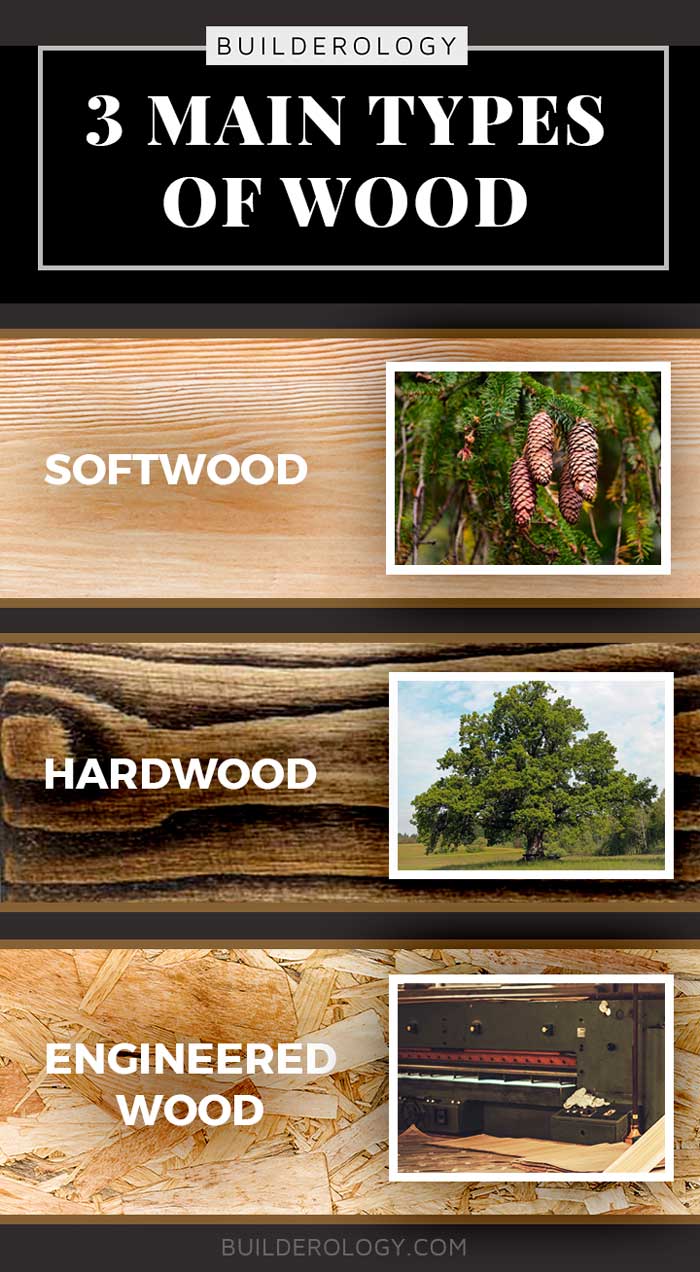
Before we get into all of the different wood varieties and their common uses, it’s important to understand the three basic types of wood you might encounter. These three types are: softwoods, hardwoods, and engineered wood. Each of these different wood types can be used in a number of different ways.
Softwoods
Softwoods are the wood and lumber which are milled from conifer trees. Scientifically known as Gymnosperms, Conifer trees are any trees which have needles and produce cones. Examples of popular softwood trees used in woodworking, construction, and furniture are Pine, Cedar, Fir, Spruce, and Redwood.
Are Softwoods Softer Than Hardwoods?
Contrary to popular belief, softwoods are not named softwoods because they are “soft”. While it is true that some varieties of hardwoods are very hard and therefore more challenging to work with, the distinction between hardwood and softwood has little to do with the actual softness or whether one wood is harder to work with. There are many hardwoods which are softer than softwoods.
How Are Softwoods Like Pine, Cedar, Spruce, Fir and Redwood Used?
Most softwoods are strong and commonly used in many different building applications. Spruce, Pine, and Fir (SPF) are commonly sold under as dimensional SPF lumber at home improvement centers. These woods are often used in framing new construction, as well as building utility style structures.
Many of these woods, particularly softwoods from the cypress family are renowned for their ability to resist rot and insects. This makes trees such as cedar and redwood ideal for exterior projects, such as decking and outdoor furniture.
Hardwoods
Hardwoods come from any trees which do not produce needles or cones. These trees are most commonly are known as deciduous trees, more scientifically known as angiosperms. Hardwoods are trees which produces leaves and seeds.
Common hardwood species include oak, maple, cherry, mahogany, and walnut. Hardwood species are not always necessarily stronger than softwoods, but many species are well known for their beautiful and distinct wood grain patterns.
There are also some woods which are considered to be hardwoods that are not deciduous trees, such as Bamboo and Palm. These plants are scientifically known as monocotyledons, but have many of the same characteristics of hardwoods and so are often classified as such. Bamboo and Palm can sometimes fall under the next classification of engineered wood.
Engineered Wood: Manufactured Wood Products
The third type of wood you may encounter are engineered woods. Engineered wood does not occur naturally in the environment but instead are manufactured.
These boards are generally made with wood which is manipulated to have certain qualities or features. Also known as composite wood, these products are often made from the waste wood of sawmills.
Engineered wood is often treated through chemical or a heat process to produce a wood product which can meet certain sizes that would be difficult to achieve from nature.
Popular examples of engineered woods include Plywood, Oriented Strand Board, Medium Density Fiber Board, and Composite Board. Wood veneers can also sometimes be classified as engineered wood, since it often needs to be manipulated either through specialized cutting techniques or joining pieces together to achieve a specific size or wood grain patterning.
Now that we understand these three main types of wood, we are ready to start exploring all of the different varieties of wood you may encounter and what they are most frequently used for.
Types of Wood for Woodworking, Furniture & Building
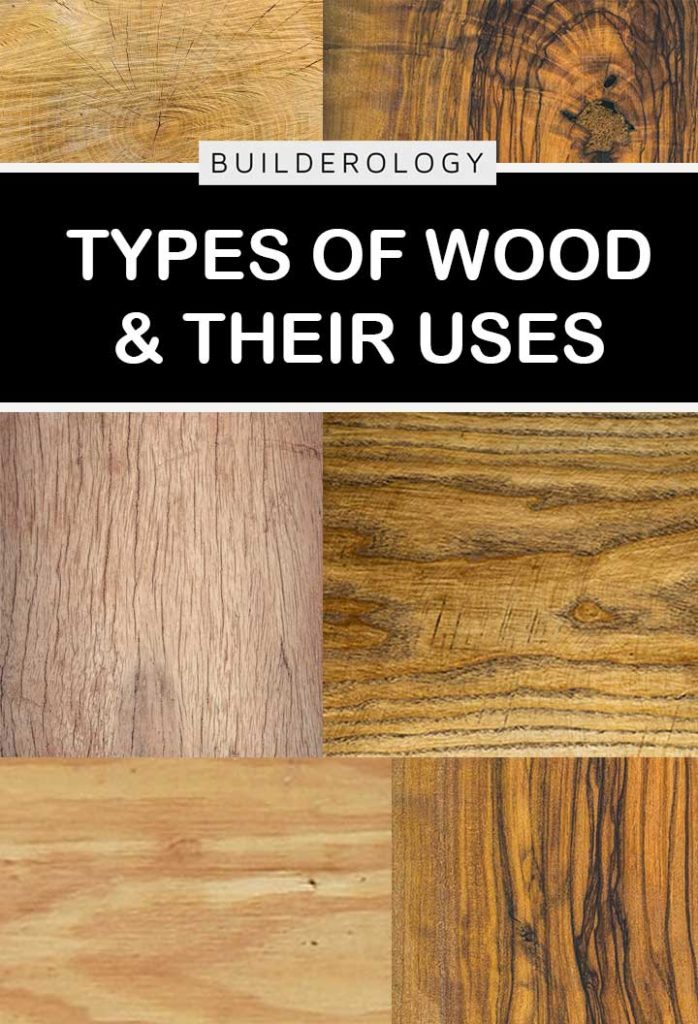
While there are three main types of wood, there are thousands of varieties and species of wood. In this section we’ll cover the most common woods you may encounter in building and woodworking. For each variety of wood, we will give an overview of their common characteristics, and what each type of wood is most suitable to be used for.
All woods are listed in alphabetical order, so if there is a specific type of wood you want to learn about, you will be able to find it easily on this list.
Alder Wood
Alder is a hardwood which is slowly gaining a rising popularity due to its natural beauty, workability and versatility. It is more frequently found in the Northwest regions of California and Southwestern parts of Canada. It is in the same family as the birch tree, so it often shares similar applications.
Alder will appear to be almost white when freshly cut, but quickly turns to warm honey brown once exposed to air and sunlight. This medium density wood usually has a straight grain and is easy to use for carving, turning, and machining.
The wood also works well with a variety of different finishing treatments. Alder wood has a very smooth surface when sanded which can easily be stained or painted.
The Alder tree does not grow to be very large in diameter or height, so this is something to consider if you need very large solid pieces as they may be more difficult and therefore more expensive to obtain.
Alder is used frequently in furniture making and cabinetry. It is also a popular choice for photo frames and other decorative objects.
Perhaps one of the more specialized uses for Alder wood is in the hard body of electric guitars. Alder wood produces a very clean tone that is hard to replicate with other woods. In electric guitars, Alder is often more desirable for its tone than even the exotic hardwoods such as mahogany.
Ash
Ash wood can be somewhat difficult to find currently, especially due to the recent issues with the Emerald Ash borer, an invasive pest which caused many of these trees to prematurely die. If you live in the areas where Ash trees are native and grow abundantly, it will be easier to find this wood than if you live somewhere that does not.
Ash mimics the same strength and characteristics of white oak but typically comes at a more budget friendly price if you are able to find it at a local lumberyard near you. The wood takes stain easily and can be used for many different types of projects.
Aspen

Aspen is a light colored wood which takes painting and stain well. This wood can sometimes appear or feel to have a fuzzy texture.
Aspen is a hardwood grown in Northeast America but can sometimes be difficult to find. Due to its general limited availability, it is typically only used for very specific projects in which Aspen wood is ideal.
One of the most specialized uses for Aspen wood is in the building of saunas. The wood does not conduct heat and can tolerate the moisture well with limited swelling or movement. Because it does not conduct heat easily, it is also sometimes used in the production of matchsticks.
These properties are also what make Aspen desirable for using to build drawer slides in furniture, since this can help reduce sticking. This wood is also odorless and taste free, making it ideal for making chopsticks and kitchen utensils.
Balsa Wood
Balsa is a very lightweight hardwood that is typically used in hobby and craft types of projects. Many fine woodworkers tend to have a negative viewpoint of balsa wood since it is not very strong, but it often under appreciated and has many practical uses.
Most of us first encounter balsa wood in childhood building projects and model kits. Balsa wood may be considered child’s play to most serious woodworkers, but it is also perhaps the very catalyst that introduces many people to woodworking and construction.
This wood also has a very rich history, especially because it was often used as a substitute during World War I and World War II in airplanes and ships.
Balsa wood is typically imported to North America from South America and Central America. Balsa wood grows very quickly but has a relatively short lifespan, with most trees only producing usable lumber before it is 10 years old.
The wood is very buoyant, and many people are surprised to learn that balsa wood is often used in building rafts, life preservers, and other types of items that are designed to float. Surfboards are a great example of beautifully crafted projects that can be made of Balsa wood.
Balsa wood is a low density wood which is generally not very strong. For this reason, many people prefer to choose basswood and birch over balsa wood for any type of project that needs to be able to handle weight or stress.
On the other hand, if you DO need to build something out of wood that can quickly break or come apart, such in the case of building sets for theatre and film stages, balsa is a great choice.
The grain of the wood can easily be painted or stained to use as a veneer in order to achieve a number of looks on the cheap.
When assembling projects that use balsa wood, it is often necessary to use glue, since the wood does not play too nicely with nails or screws. Very thin pieces of balsa wood can often be cut with nothing more than a good utility or craft knife.
Bamboo

Although Bamboo is technically a grass and not a wood, it can be used for building many things due to the hardness and density of the plant stems. Bamboo grows in abundance in tropical climates and there are a number of different species available, which vary greatly between regions.
The Bamboo plant has a tall, hollow stem. These stems can be used as-is, or they can be cut into very thin, narrow strips to create a veneer. The veneer product from the stems is made into an engineered wood such as plywood.
While people might think that Bamboo would be lightweight, soft, and easy to bend or cut this is not the case. It is better to compare Bamboo to the hardwood Red oak or Maple, since it has a similar hardness and strength. The high density grass can sometimes be tough on tools.
Bamboo stems are especially popular for garden furniture, garden decorations, fences, and privacy screens. You can also see bamboo in cabinets, fine furniture and even as hardwood flooring.
Part of what makes Bamboo able to resist decay outdoors is its natural waxlike coating. If you wish to stain, paint, or glue bamboo, you will need to sand the wood first to ensure the paint or glue grips to the wood. Most bamboo should be sealed and protected for longevity if it is used outdoors.
Moisture can cause Bamboo to swell or shrink, so it is best to let it acclimate to the environment before cutting, especially if you are in a drier and colder climate than where the plant is natively grown.
Basswood
Basswood is a very light cream-colored wood, and has a very straight and tight grain. The wood is not prone to warping or movement once properly acclimated and dried.
Basswood is a hardwood favorite for woodcarvers and woodturners. It is also a very popular choice for those who enjoy miniature woodworking and building models. Woodturners often enjoy working with basswood due to its ease of use and availability.
The wood also has no odor, taste, or known allergens so it makes it a popular choice for food storage crates or even possible use in kitchen utensils. Basswood is easy to find and typically budget friendly.
Basswood can be challenging to stain evenly. In most cases it is best to appreciate simply the natural finish with a protective clear coat of oil or to paint the wood. Many decorative painters enjoy working with basswood projects because once it is primed will allow for a very smooth finish.
Beechwood
Beech is a hardwood that is often used for wood veneers, furniture, and woodturner objects. This cream toned wood has a consistent grain pattern which is usually straight and tight, and occasionally will have gray flecking. The wood is very light in color, but usually has a yellow-reddish cream tone to it.
It is a sturdy wood best known for its ability to easily steam-bend. For this reason, beech is an excellent choice for making any type of interior furniture, such as chairs and other curved pieces. This benefit however can also mean that Beech wood will sometimes suffer from movement, shrinkage and swelling when exposed to high humidity or unpredictable moisture in the environment.
Beech is often found in pianos, used for the bridge and pin blocks of the piano mechanism.
Beechwood is in the more affordable range of hardwoods, and can be found in a wide range of sizes and as a veneer. The wood is relatively easy to work with as long as your tools are sharp. It can be glued and stained without too much difficulty if desired.
Birch Wood
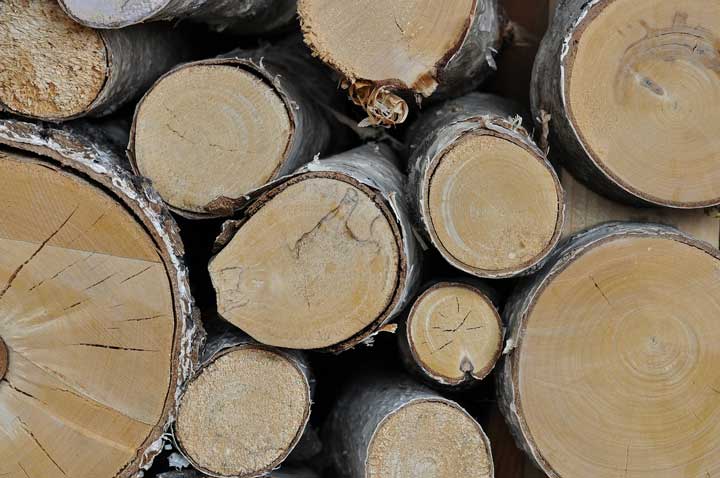
Birch is a hardwood which is easy to find and often one of the more affordable hardwood species at local lumberyards and home centers.
Birch is very strong and can be used for almost everything and anything you can imagine. Many people use birch as a less expensive alternative to Oak.
One thing to know about birch wood however is it can be very difficult to stain. Staining can sometimes result in blotchy patches that look uneven. For this reason, birch is an ideal and economic hardwood to use if you plan to paint your project.
California Redwood

California redwood trees are a popular softwood for outdoor building projects.
California redwood trees are a softwood known best for their massive size and red color. It has a very interesting wood grain pattern, and much likes its Cedar cousins, Redwood is very suitable for outdoor applications due to its ability to be weather resistant.
Redwood is often used for railroad ties and trestles, and it is also popular to use in building retaining walls, decks, and garden borders. Redwood is also a suitable choice for veneers, tables, and large cabinetry projects.
Cedar Wood
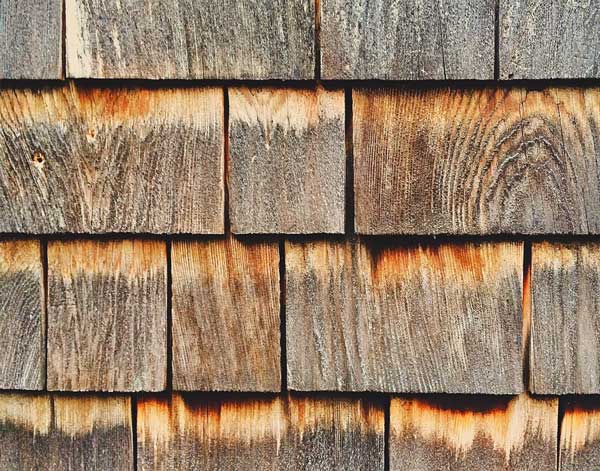
Many people are familiar with cedar not just for its interesting wood grain and color, but also for its aromatic smell which is believed to repel pests and moths. The aromatic scent and bug repelling properties is why it is sometimes a popular choice to use in closets and storage chests.
Cedar is also an ideal choice for outdoor building projects. This wood is often considered to be rot resistant and can withstand the rugged weather outdoors quite well. For this reason, many people use cedar for outdoor use, such as decks, patio furniture, fencing and decorative siding.
There are a number of different species of cedar wood, which are members of the Cypress family. Certain cedar species are better for specific applications than others.
Common Varieties of Cedarwood:
- Western Red Cedar
- Eastern Red Cedar
- Northern White Cedar
- Yellow Cedar
- Spanish Cedar
While many people adore cedar for its aromatic properties, it is important to remember that some people may be sensitive to the naturally occurring oils. If you plan to work with cedar wood, it is important to wear gloves and wear a mask to reduce inhalation of the sawdust.
Due to high likelihood for irritation, Cedar should not be used for kitchen utensils or any other projects that would be used with food or have prolonged contact with skin.
Cherry
Cherry is a beautiful wood which comes from the American Black Cherry fruit tree. This wood often starts as a light pink color that darkens and changes to a reddish hue over time. Cherry wood can sometimes have black flecking, which occurs naturally from mineral deposits over time.
When selecting cherry wood, you may want to take some time to try and ensure the pieces you select all match. Cherry can be stained, but most people opt for its natural state and will give it a clear protectant finish to let the beauty of wood and natural patina process that occurs with aging stand out.
Douglas Fir
Fir is another great economical and strong softwood to consider working with for beginning woodworking projects. Fir is usually a good choice for projects you plan on painting, since it can be sometimes difficult to stain and really does not have much of a wood grain.
Most varieties of fir have a very tight wood grain, which gives it a bit more strength and stability compared to pine. Fir is commonly used for construction and utility projects where a natural wood grain finish isn’t especially important.
Ebony

An example of Ebony wood. Photo Credit.
Ebony wood is easy to identify, since this is one of the few woods that are truly black in color. It is a very dense hardwood and has many characteristics that make it desirable for a number of wood carving and specialized woodworking projects.
It is important to note that ebony is a protected species and is often heavily regulated worldwide. Cameroon is the only country where the wood can be legally harvested, and the harvesting practices are not always ideal.
For this reason, it can sometimes be very difficult to obtain ebony wood. The tree is very slow growing, which contributes to its scarceness. Historically ebony was used in the production of musical instruments, used to make the black keys on pianos and in the fretboards for guitars.
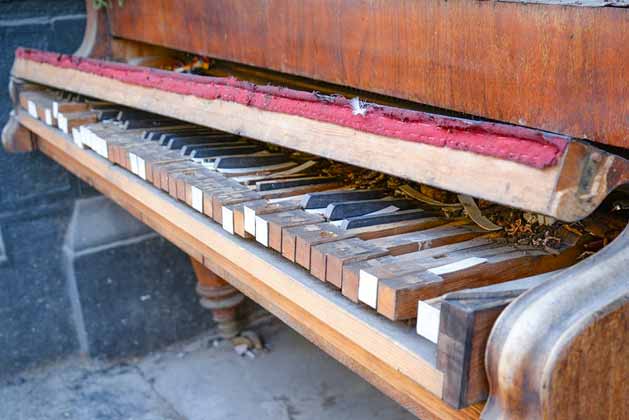
Older pianos and musical instruments that are no longer playable could be an interesting source for reclaiming old ebony wood. Antique pianos very likely may have true solid ebony keys, although often times the black keys were made with other wood types.
As a carving medium, ebony produces a beautiful finish and is able to hold detail. Most woodworkers suggest using only hand tools with ebony, as the denseness and hardness can be challenging to machine. You will definitely want to reach for the carbide tipped blades for any type of work you may do with ebony.
Ebony should not be painted and it can sometimes be a challenge to glue. In most cases, ebony is best finished with very fine sanding and buffing and then waxed. One should avoid any type of sealers or varnishes with this wood.
Many cabinet makers who wish to achieve similar looks to ebony but using more sustainable woods often choose cherry or walnut and then stain it to a dark rich black color. This not only saves on costs and promotes sustainability, it can also be much less challenging to build with cherry and walnut compared to ebony.
Hardboard (Commonly known as HDF: High Density Fiber Board)

Hardboard is an engineered wood product which is made from highly compressed wood fibers. This board can be made using a wet or dry process, and the process used will determine whether the wood has two “good sides” or only one “good side”.
Hardboard has a distinguishable texture and no grain pattern, so it is usually paired with a wood veneer that can be stained. Hardboard can be painted, though surface preparations usually need to be made to ensure the paint will not later peel or chip off.
Chalkboards are sometimes made with a type of engineered wood such as hardboard and then coated with a layer of flat paint. This can also be a very quick and easy way to make your chalkboard, and you can always build a frame with a nicer wood as a decorative touch.
Hardboard comes in many different varieties, and often goes by different names. Masonite is one type of hardboard that is commonly used in building sets and props in theatre. It is often also used by construction and moving companies to be used temporarily to protect floor surfaces and to make it easy to move items on dollies or carts.
Tempered hardboard means that the board was treated with linseed oil and then baked. This process can help make it more durable, improve moisture resistance and gives it more strength.
Pegboard, also known as Perforated Hard Board is a tempered hardboard which has holes that are uniformly drilled into it. These holes are usually 1/8 of an inch in diameter and typically have a 1/4″ spacing between each of the holes. Pegboard is commonly used for storage and as display racks and it can be a great way to organize your garage or workbench.
While hardboard is not a first choice for building premium furniture, it can help add support and strength to economically build many furniture pieces, such as the backs of television stands and entertainment centers. It is also often used as a backing for dressers and cabinets, especially since these parts are usually against a wall and will not be visible.
Hardboard is available at almost any home improvement center, you can also confidently order it online. Since the engineered wood product is manufactured uniformly you can order it online with confidence without worrying about defects or variances between pieces like you would encounter with natural woods.
Hardie Board: Fiber Cement Board
It’s important to not confuse hardboard with hardieboard or hardie backer board. While the names may sound similarly confusing, they are very, very different things.
Hardie board is a composite construction building material that is the brand name of fiber cement board. The reason fiber cement board is often called Hardie board is because the James Hardie Brand is one of the top companies which manufacture and produce this product.
Fiber cement board is made primarily from cement and cellulose fibers. While it is an engineered board, it is not typically classified as “wood” and is not used as a substitute for wood in most applications.
Fiber cement board is most frequently used as a substrate for tile flooring and walls. The James Hardie company also manufactures composite fiber cement decking and siding.
Larch / Tamarack
Larch wood, also known as Tamarack wood, is of the tree species in the Larix family. Larix laricina is the variety most known as Tamarack and is commonly found in North America. In Eurasia, the species is more commonly Larix decidua and more frequently known as Larch.
Technically a softwood, the Larch trees are an unusual type of tree in the Cypress family. What makes this specific tree unusual as a softwood is that it meets both the criteria to be classified as both softwoods and hardwoods.
It is undeniably a conifer tree that has needles and produces cones, but the tree species is also classified as being deciduous since it sheds its needles similar in the way most trees lose their leaves in the autumn.
Among softwoods, it is known to be one of the strongest and hardest. Since it is in the Cypress family of trees, it shares many common characteristics of its Redwood and Cedar cousins.
Tamarack typically has a reddish brown tone and is resistant to rotting and pests, making it an ideal choice for outdoor projects. The straight grain and hardness of the wood can make it more prone to splintering and chipping when working with it.
As is common with trees in the Cypress family, it is important to note that this wood may cause irritation or allergic sensitivity. The resins and oils of the plants which make it desirable for its rot resistance can sometimes cause issues for certain people.
For this reason, these woods should generally be limited for uses that will not come into prolonged contact with skin. If you are working with these woods, you will want to make sure you take precautions to limit any irritation from inhaling sawdust and wear gloves to limit your topical contact with the resins and oils of the wood.
Luan (also spelled Lauan)
Luan is typically found as a plywood which is made from the wood of Shorea trees native to the Philippines and other Southeast Asian countries. The Lauan tree in the Shorea family is a flowering species. While technically a hardwood, it is most likely we will encounter the wood in manmade engineered forms such as plywood.
This plywood is typically only available in very thin pieces, usually either 1/8th of an inch thick or 1/4th of an inch thickness. It is usually available in large 4′ x 8′ sheets, although some stores may offer smaller pre-cut pieces.
This wood is very flexible and can bend easily. This gives it a unique property that can make it very useful in building miniatures and models. Being lightweight and relatively inexpensive with reliable availability also makes it popular to use in other craft and hobby projects.
Luan is sometimes used much in a way as hardboard is to add some stability or a false back to a piece of larger furniture pieces, though this is more often just for “looks” than for actual function.
It’s important to note that since luan features a willingness to bend and comes in a very thin piece, it should not be used for applications where it would be under a lot of pressure or is necessary for structural strength.
Luan is sometimes referred to as “Philippine Mahogany”, but it is important to know that it bears to actual relation to true mahogany wood, which we’ll cover next.
Mahogany
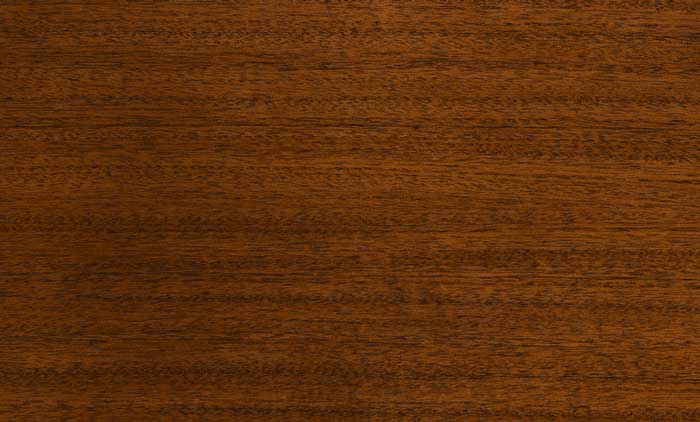
Mahogany is a beautiful exotic hardwood and a premium wood for furniture making. The wood often starts with a pinkish tone that will deepen and darken over time.
It is easy to work with and takes stain beautifully – often times this wood only needs a simple coat of oil. Out of all of the hardwoods, mahogany is softer than many of them, which makes it easier on your tools.
Many musical instrument manufacturers also use Mahogany in the construction of guitars and pianos because it produces a clean tone acoustically.
Mahogany wood is typically imported from South and Central America, and for this reason it can be quite costly to purchase and difficult to find. These varieties are known as Tropical Mahogany.
If you do choose to use Mahogany for a project, you may wish to make sure the wood you choose is grown sustainably. Sadly many times the demand for this wood can cause massive deforestation when it is not obtained from sustainable sources.
There are also other types of Mahogany. Australian Mahogany is one you may encounter, with similar properties but quite different since it is from the Eucalyptus family of plants. Philippine Mahogany is also very different, and usually is considered to be a very “cheap” type of wood like Luan.
Maple
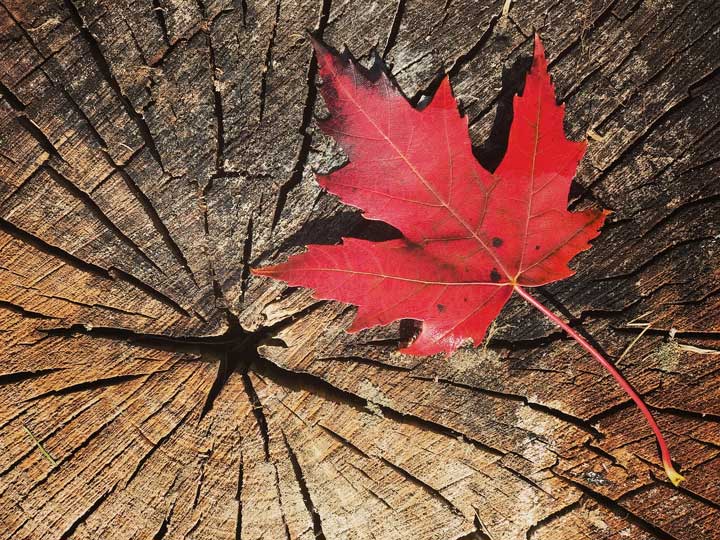
Maple is a beautiful hardwood which is often used in applications where the natural wood grain is visible. Maple is grown primarily in sustainable North American forests.
There are a number of different species of Maple trees, and so for this reason when shopping for Maple you may notice there are two basic varieties to choose from: soft or hard. Hard maple is from the Sugar Maple tree, where the soft maple typically is from Red Maple trees.
Red Maple, also called soft maple is usually the top choice for woodworking, since it is much easier on the tools.
Sugar Maple, also called hard maple can be difficult to cut and work with. Due to its hardness, Sugar Maple makes for a very popular choice for hardwood flooring. This variety of maple can take the abuse of being walked on and holding furniture without any indentations or scuffs.
MDF: Medium Density Fiberboard
Medium density fiberboard, more commonly known as MDF is another engineered wood product that is similar to HDF, or high density fiberboard, but with a lesser overall density.
The differences in fiber density make MDF more suitable for different uses than Hardboard. For example, MDF has greater acoustic and insulating properties, so it is sometimes used in applications where that is desired, such as the inside of a speaker.
In general, MDF is not a desirable product to use in woodworking. It can be difficult to work with, and many people are concerned about the chemicals the engineered wood product may leach into the environment, specifically Formaldehyde.
MDF is one of those things you should know about in case you ever encounter it, but in most cases you would probably not want to use it if you can avoid doing so.
Oak

Perhaps one of the most loved hardwoods, oak is a very popular choice for woodworkers, especially in building furniture and high quality heirloom pieces that can last for generations.
The two main varieties of oak wood you will encounter are white oak and red oak. Red oak has a more reddish hint of a color to it, and is typically what is most readily available at the majority of lumber stores. Red oak is slightly softer than white oak, which makes it a little bit easier to work with when building.
White oak is a very hard hardwood and is an excellent choice for hardwood flooring. Oak is also resistant to rot and decay, so with the proper treatment and sealing can be used in outdoor applications.
One important thing to know about working with oak is that it absolutely must be acclimated to your shop before working with it. Oak is prone to swelling and shrinkage depending on the temperature and moisture conditions, so it is important to take this into consideration, especially when using for flooring or if making containers such as wooden buckets that would hold water.
Oak is easy to stain, and so it is a wonderful choice for a number of different stained finishes. You can also paint oak, though most woodworkers would agree that it would be a waste, especially when you could use similarly strong woods that are less expensive if you are planning to paint over and cover up the beautiful natural wood grain.
Oriented Strand Board (OSB)
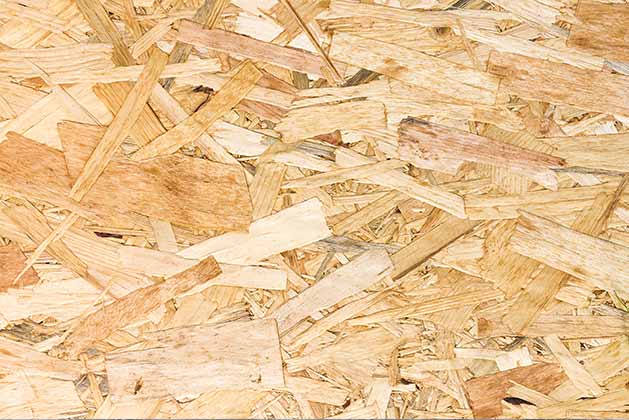
Oriented Strand Board, more commonly known as OSB is a type of engineered wood product that is often used as an alternative to plywood. The wood is made using strands of wood which are arranged in a cross-hatched pattern to combine with resin and go through a thermal heating process.
The boards are generally uniform in size and thickness, but it has a very distinct texture to it. OSB can often be painted, but the texture of the wood strands will be hard to avoid.
You will often find that OSB is considerably less expensive than plywood. For this reason, OSB is commonly be found in new construction of residential homes. Many people use it as sheathing for floors, walls, and roofs.
OSB is also used in constructing cheap laminate furniture. In most of these cases, the OSB is covered with a veneer. Only in places where the end grain is visible is it possible to know it is OSB, such as in the photo example shown here.
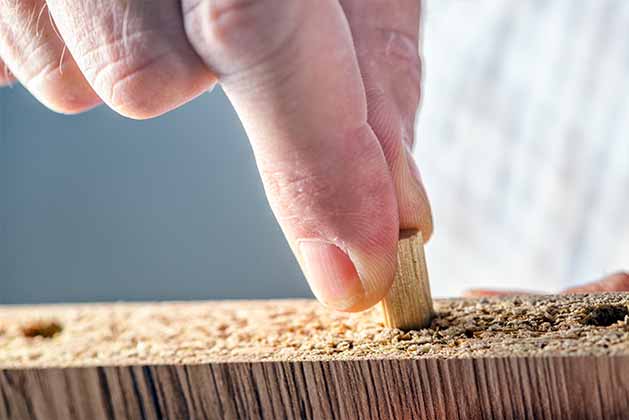
While these furniture pieces may be inexpensive, they are definitely a lesser quality than those built with natural woods. A simple tap of a hammer can cause poorly designed laminate furniture piece made of OSB completely collapse.
For this reason, most woodworkers would never use it for building furniture, opting instead to work with real wood. While it is never a first choice for fine woodworking, OSB certainly can be useful and cost effective for a number of utility purposes.
OSB should not be intended for exterior use. These boards will often start to break down after prolonged exposure to the outdoor elements.
Pine
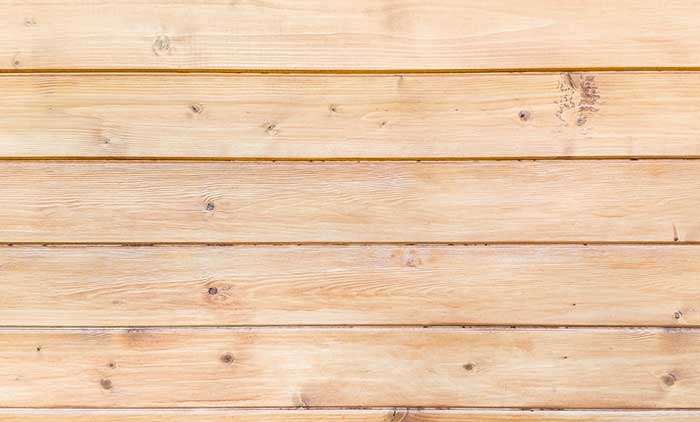
Pine is a very common and versatile softwood which has many practical applications. Pine typically is considered to be economical, sustainable and durable, which makes it a popular choice for a number of different projects.
Most pine trees grow very tall and quickly and they are often grown in sustainable forestry conditions, which means more trees are planted than are ever cut down in any given year.
There are several species of pine, all of which have various different characteristics. Southern Yellow pine, as the name implies, may have a more yellow hue to it than the white or sugar pine varieties. White Pine and Sugar pine are sometimes also referred to as clear pine.
With pine, you can decide whether to stain it, paint it, or simply finish it with a clear coat of protectant sealant. Pine behaves very well for staining a wide variety of colors and tones as long as you properly prepare the wood beforehand.
Pine can also sometimes be found in dimensional lumber that is sold under the generic terms “SPF lumber” and “White Wood”. SPF stands for “Spruce, Pine and Fir”.
Most pine is best suited for indoor use only, unless it has been specifically treated to be used in outdoor applications, as in the case of pressure treated lumber, which is also covered in this list of types of wood.
Plywood
Plywood is an engineered wood product, though it is made with real wood. Plywood is made by adhering multiple layers of veneer together and compressing them.
Plywood can come in a variety of different wood finishes, and most plywood has a “good side” and a “rough side”.
Plywood is available in a variety of different thicknesses, with quarter-inch, half-inch, and three-quarter inch sizes being the ones you will most likely encounter at home improvement stores. Most plywood used in construction is made of fir, pine, or spruce.
Pressure Treated Lumber
Pressure treated wood is typically yellow Southern Pine wood which is made to be rot resistant and pest resistant through a chemical process. Some pressure treated lumber is also made from SPF wood, which is a generic acronym for Spruce, Pine, and Fir.
You will often see pressure treated lumber used to build decks, patios, porch railings, and other outdoor structures. Due to pressure treated lumber being rot resistant, it is often possible to reuse old pressure treated wood to use for new building projects.
If you do decide to use pressure treated wood in your projects, be sure that you use either new wood or wood which was manufactured after the year 2005.
Pressure treated lumber used to be quite toxic, even containing poisonous heavy metals such as Arsenic. Fortunately, today’s wood is much safer, although it’s generally recommended it should only be used for items that will not come in contact with food. There is much controversy over whether or not pressure treated lumber is safe to use in raised garden beds used to grow food.
Poplar
Poplar is a popular and economical hardwood to use for a number of different building projects and applications. The wood is very light in color, and may even appear as white. It does not have a very distinguishable nor necessarily attractive wood grain, so poplar is often painted or used in places where it is not visible.
Of all of the hardwoods, poplar is a very soft wood, which makes it easy to work with, but also means it can be very easy to indent or knick while working with it.
Poplar is less prone to warping or movement. Since it is not exactly the prettiest of woods for this reason it is often used in parts of furniture that are not visible, such as drawer slides or the inside pieces of dresser frames.
Poplar is also often used in model building, as well as for many wood crafts. It is readily available at most stores that sell lumber as well as available in smaller pieces at hobby and craft stores that sell wood for craft projects.
Rosewood
Rosewood is music to a woodworker’s ears – this wood is most commonly used in the construction of guitars, pianos, and other wood musical instruments.
Rosewood is an exotic hardwood, which often contributes to the expensive price of popular musical instruments. Brazillian rosewood is common, although it can also come from Madagascar or Asia. Many people are concerned about illegal logging and deforestation practices that may occur in harvesting rosewood, so for this reason many people may choose alternative woods in their projects.
Rosewood is also a known irritant for many people, especially with prolonged exposure to the saw dust that may happen when cutting the wood. If you are working with rosewood, it is very important to use the proper wood safety precautions.
SPF Lumber
SPF lumber is not a specific species of wood, but rather a generic term to include Spruce, Pine, and Fir, which is how the acronym SPF came to be used and known.
All of these woods are softwoods that have similar properties and characteristics, though there are noticeable differences to the well trained eye.
SPF lumber is most commonly used for interior construction framing and utility purposes. Because lumber is a commodity, often times the type of wood you actually get as SPF will largely depend on current supply and demand conditions.
SPF is best used for utility purposes or for framing interior walls. The wood is generally not able to withstand the harsh conditions of exterior use unless it is chemically altered and pressure treated.
In most cases, SPF is usually used in cases where the wood will not be seen or exposed, such as is the case for framing. This wood can typically be sanded smooth to be painted but usually is not ideal for staining, since blotchiness is common.
SPF lumber is generally very inexpensive, but sometimes it can cost more in the long run when trying to use it for finer woodworking projects, especially if you need to take a lot of time making the wood usable for what you want to build.
It’s also important when purchasing SPF lumber to try to purchase from the same stack of wood all at once, as this will increase the odds that at least all of the wood you purchase will be the same species and share the same characteristics.
When working with SPF lumber in woodworking, you will likely want to purchase more than you think you need, simply because this wood can occasionally be unpredictable.
It is also important to make sure you give the wood time to acclimate to your shop’s humidity and temperature to avoid major shrinking and swelling when making cuts and assembling your projects.
Spruce
Spruce is an evergreen softwood tree, and as mentioned previously is commonly found in lumber yards as “SPF lumber” which is frequently used for construction framing projects.
Spruce has a very light color, and therefore sometimes may also be sold under the generic umbrella of “White Wood”, especially in the cases of large home improvement retail chains. It has a straight and subtle grain.
When spruce is permitted to grow to its peak maturity, it can have excellent accoustic properties that make it desirable for the construction of musical instruments such as pianos, guitars, and other string instruments.
Historically, spruce has been used to build aircraft and boats. The first airplane built by the Wright Brothers was constructed from Spruce. but spruce is prone to swelling and not especially weather resistant so it is no longer typically used for these applications.
Teak
Teak is an exotic hardwood native to the Asian rainforests. It takes a very long growing cycle, with the average tree needing 60 years before it reaches maturity to be harvested.
While there are more sustainable forestry practices in place today than there were decades ago, this long growing process means that teak will always be a difficult wood to find that comes with a very premium price.
Teak was originally used most commonly for boat building and is still a favorite amongst nautical crafters and artisans. It is also very popular to use in premium outdoor furniture, decking, and other outdoor applications.
Teak has a naturally oily finish, which can make it difficult to stain or glue in some instances. The wood is also quite hard, and so you may notice that you need to sharpen and replace blades more often when working with it.
Teak has an aroma that a lot of people would describe as being very distinct and earthy. Many people can be extremely sensitive to the naturally occurring oils in the teak wood, so it is important to not use teak for any type of application that would have prolonged and direct contact with food or skin.
When working with teak, it is also wise to use a dust respirator and gloves. This will help reduce the irritation you may experience while working with the wood. If you are concerned about sensitivity or allergies, it is best to avoid teak and instead choose a more hypoallergenic wood for your projects.
Walnut
Walnut is a hardwood that is best known for its rich brown and dark coloring. Walnut can be expensive and often is only available through specialty lumber stores, but it is a beautiful wood to consider for special projects.
Walnut is relatively easy to work with, but is also very strong. It can be used in hardwood flooring, although many people may opt to still choose maple or white oak and stain those woods to match the desired shade of walnut because they are slightly more durable.
Walnut is a fine grained wood which polishes up quite nicely and can easily be stained and protected. Many people enjoy using it for carving, routing, and as decorative accents for wood furniture. Walnut cabinets are very popular, though it is common for less expensive woods to be stained to match a walnut color.
Many people are also surprised to learn walnut is used in high end luxury car manufacturing and in gun making. The fibers of the walnut tree are very dense, which makes it able to withstand the shock and force the wood might experience in these types of uses.
Musical instruments such as guitars and violins can also commonly be made of walnut. While walnut is one of the more expensive hardwoods, it is still a much more economical choice over other exotic hardwoods that are desirable for producing clear tones for music instruments.
Whitewood
“Whitewood” is not a specific species or type of wood, but instead is a generic term to describe a wide variety of different woods that have similar characteristics in strength and color.
Whitewood is a term most frequently used by the big box retail stores and they use this term in order to have one SKU number for a number of different woods based on availability. This wood can sometimes be Pine, Poplar, or Douglas fir.
Basically, if something is sold as “whitewood” you typically have no idea what type of wood you may actually be getting. This type of wood is often sold as dimensional lumber and used in construction and framing projects.
If you learn the secrets to identify different wood species, you can sometimes find some great deals on woods such as poplar and pine in the generic “white wood” section, but you also have to be careful because sometimes the lesser grades of fir are also sold as whitewood.
Whitewood is basically the “box of chocolates” in the lumber world – you never know what you might get.
Zebrawood
Lastly, but certainly not least, is the exotic wood known as Zebrawood. There are several varieties of Zebrawood, most of which are native to Central America and Central Africa.
This wood is characterized by its prominent striping pattern in the wood grain. It is most commonly used for premium furniture due to the nature of its unique pattern. It is a very heavy, hard wood that can be sometimes difficult to work with.
Zebrawood historically was most commonly found in high end luxury items. The density and hardness make it desirable for manufacturing in things such as cars, guns, and other items that would require it to withstand shock and vibration.
Today it is most often seen as a wood veneer that is used to give decorative accents to different furniture pieces. There is much concern over the sustainable and legal logging of this exotic wood, so if you want to ensure your projects are environmentally friendly you may wish to look at other hardwood alternatives.
Whatever You Want to Build, There’s The Perfect Type of Wood For You
Now that we’ve gone over all of the different wood types and varieties out there to choose from, as well as explain many of their common uses and characteristics, hopefully it will be much easier for you to choose the right wood to use in your project.
Whether you are building indoors or outdoors, making a simple shelf or hand carving an intricate work of art, there’s the perfect wood out there for your project!
Do you have any questions about the many varieties of wood and wood types? Which woods are your favorite choices for different projects? Share your experiences in the comments below – we’d love to know what woods you love to build with!